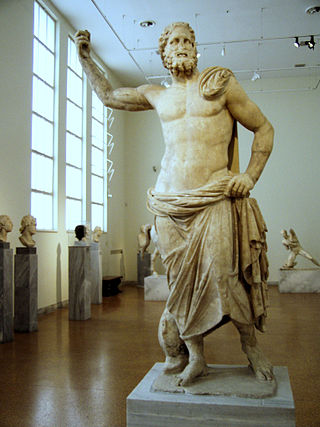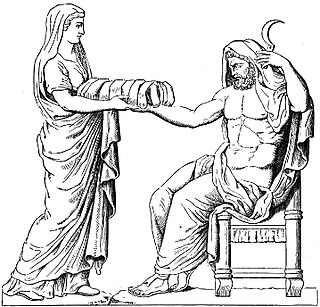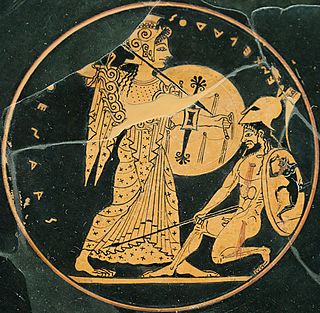
The Temple of Athena Lindia was a sanctuary in Lindos in Rhodes, dedicated to the goddess Athena. It was a significant Pan-Hellenic shrine of Athena and arguably the regional center of her cult.

The Temple of Athena Lindia was a sanctuary in Lindos in Rhodes, dedicated to the goddess Athena. It was a significant Pan-Hellenic shrine of Athena and arguably the regional center of her cult.
The sanctuary was situated at the acropolis in the city of Lindos in Rhodes, which was at that time the capital of the island. Prior to the foundation of the temple, the site appears to have been the place of the cult of a local goddess. It was built above a natural cave in the cliff, which may have been a previous cult place.
The first temple is dated to the 6th century BC. It was likely built by Cleobulus. The cult statue of Athena Lindia has been reconstructed from the votive statuettes as a seated figure of Athena with a polos crown.
The temple was burned in 342 BC, and replaced by a new temple in the late 4th-century BC. It was built in the Doric style. It was 7.75 x 21.65 m. The new cult statue was a standing figure of Athena carrying a shield, but wearing a polos rather than a helmet; as it was fastened by the wall of the cella, it may have been over life-size.
The fame of the temple is confirmed by the fact that Alexander the Great and many of his successors offered sacrifices there, and dedicated weapons after victories. Many of its votive gifts were famous and mentioned in the Temple Chronicle, such as works of Boethus and painter Parrhasios of Ephesus.
The island of Rhodes was noted as a significant place for the cult of Athena in ancient times, and the sanctuary and cult of her in Rhodes are mentioned alongside to that in Athens. Rhodes was an important place in the myth of the birth of Athena, and it was said that:
According to legend, the temple was founded by Danaus and the Danaïdes. According to Pseudo-Apollodorus (2 cd-Century BC), the temple was founded by Danaus, who dedicated a statue to Athena Lindia in his gratitude for her assistance in helping him construct a ship, by which he could help his daughters to escape: "Danaus, in fear of the sons of Aigyptos, under Athena's supervision built a ship (the first man to do so), put his daughters [the 50 Danaïdes] on board and escaped. Putting in at Rhodes, he dedicated the statue of Athena Lindia. From there he went to Argos." [2] Strabo described the temple as founded by the Danaides rather than their father: "In Lindos there is a famous temple of Athena Lindia, founded by the daughters of Danaüs." [3] According to Callimachus, the cult image of Athena put in place by Danaus was originally a xoanon before it was replaced by a statue, which indicates that the temple was of considerable antiquity. [4] [5]
Pindar described the legends around the temple in the 5th-century BC:
The cult of Athena on Rhodes differed somewhat from the cult in other parts of Greece, as it required the burning of the entrails from the sacrificial animals on the altar, an act which may have been unique for Rhodes. Philostratus the Elder describe the cult on the sanctuary in 3rd century:
The sanctuary was excavated by the Italian archaeologists Maiuri and Jacopi in 1910–1932, and then by the Danish archaeologists K.F. Kinch and Chr. Blinkenberg.

Apollo is one of the Olympian deities in classical Greek and Roman religion and Greek and Roman mythology. Apollo has been recognized as a god of archery, music and dance, truth and prophecy, healing and diseases, the Sun and light, poetry, and more. One of the most important and complex of the Greek gods, he is the son of Zeus and Leto, and the twin brother of Artemis, goddess of the hunt. He is considered to be the most beautiful god and is represented as the ideal of the kouros. Apollo is known in Greek-influenced Etruscan mythology as Apulu.

Athena or Athene, often given the epithet Pallas, is an ancient Greek goddess associated with wisdom, warfare, and handicraft who was later syncretized with the Roman goddess Minerva. Athena was regarded as the patron and protectress of various cities across Greece, particularly the city of Athens, from which she most likely received her name. The Parthenon on the Acropolis of Athens is dedicated to her. Her major symbols include owls, olive trees, snakes, and the Gorgoneion. In art, she is generally depicted wearing a helmet and holding a spear.

In ancient Greek religion, Hera is the goddess of marriage, women, and family, and the protector of women during childbirth. In Greek mythology, she is queen of the twelve Olympians and Mount Olympus, sister and wife of Zeus, and daughter of the Titans Cronus and Rhea. One of her defining characteristics in myth is her jealous and vengeful nature in dealing with any who offended her, especially Zeus's numerous adulterous lovers and illegitimate offspring.

In ancient Greek mythology and religion, Leto is a goddess and the mother of Apollo and Artemis. She is the daughter of the Titans Coeus and Phoebe, and the sister of Asteria.

Poseidon is one of the Twelve Olympians in ancient Greek religion and mythology, presiding over the sea, storms, earthquakes and horses. He was the protector of seafarers and the guardian of many Hellenic cities and colonies. In pre-Olympian Bronze Age Greece, Poseidon was venerated as a chief deity at Pylos and Thebes, with the cult title "earth shaker"; in the myths of isolated Arcadia, he is related to Demeter and Persephone and was venerated as a horse, and as a god of the waters. Poseidon maintained both associations among most Greeks: he was regarded as the tamer or father of horses, who, with a strike of his trident, created springs. His Roman equivalent is Neptune.

In ancient Greek religion and mythology, Hestia is the virgin goddess of the hearth and the home. In myth, she is the firstborn child of the Titans Cronus and Rhea, and one of the Twelve Olympians.

Rhea or Rheia is a mother goddess in ancient Greek religion and mythology, the Titan daughter of the earth goddess Gaia and the sky god Uranus, himself a son of Gaia. She is the older sister of Cronus, who was also her consort, and the mother of the five eldest Olympian gods and Hades, king of the underworld.
In Greek mythology, Danaus was the king of Libya. His myth is a foundation legend of Argos, one of the foremost Mycenaean cities of the Peloponnesus. In Homer's Iliad, "Danaans" and "Argives" commonly designate the Greek forces opposed to the Trojans.
In ancient Greek religion and mythology, Adrasteia, also spelled Adrastia, Adrastea, Adrestea, Adastreia or Adrasta, originally a Phrygian mountain goddess, probably associated with Cybele, was later a Cretan nymph, and daughter of Melisseus, who was charged by Rhea with nurturing the infant Zeus in secret, to protect him from his father Cronus. By at latest the fifth century BC, she became identified with Nemesis, the goddess of divine retribution.

Britomartis was a Greek goddess of mountains and hunting, who was primarily worshipped on the island of Crete. She was sometimes believed to be an oread, or a mountain nymph, but she was often conflated or syncretized with Artemis and Aphaea, the "invisible" patroness of Aegina. She is also known as Dictynna or as a daughter of Dictynna (Δίκτυννα).

Eileithyia or Ilithyia was the Greek goddess of childbirth and midwifery, and the daughter of Zeus and Hera. In the cave of Amnisos (Crete) she was related with the annual birth of the divine child, and her cult is connected with Enesidaon, who was the chthonic aspect of the god Poseidon. It is possible that her cult is related with the cult of Eleusis. In his Seventh Nemean Ode, Pindar refers to her as the maid to or seated beside the Moirai (Fates) and responsible for the creation of offspring. Her son was Sosipolis, who was worshiped at Elis.

Typhon, also Typhoeus, Typhaon or Typhos, was a monstrous serpentine giant and one of the deadliest creatures in Greek mythology. According to Hesiod, Typhon was the son of Gaia and Tartarus. However, one source has Typhon as the son of Hera alone, while another makes Typhon the offspring of Cronus. Typhon and his mate Echidna were the progenitors of many famous monsters.
In Greek mythology, the Telchines were the original inhabitants of the island of Rhodes and were known in Crete and Cyprus.

Hebe, in ancient Greek religion and mythology, often given the epithet Ganymeda, is the goddess of youth or of the prime of life. She functioned as the cupbearer for the gods and goddesses of Mount Olympus, serving their nectar and ambrosia. People of Sicyon also worshipped her as the goddess of forgiveness or of mercy.

Lindos is an archaeological site, a fishing village and a former municipality on the island of Rhodes, in the Dodecanese, Greece. Since the 2011 local government reform it is part of the municipality Rhodes, of which it is a municipal unit. The municipal unit has an area of 178.9 km2. It lies on the east coast of the island. It is about 40 km south of the city of Rhodes and its fine beaches make it a popular tourist and holiday destination. Lindos is situated in a large bay and faces the fishing village and small resort of Charaki.

The Temple of Athena Nike is a temple on the Acropolis of Athens, dedicated to the goddesses Athena and Nike. Built around 420 BCE, the temple is the earliest fully Ionic temple on the Acropolis. It has a prominent position on a steep bastion at the south west corner of the Acropolis to the right of the entrance, the Propylaea. In contrast to the Acropolis proper, a walled sanctuary entered through the Propylaea, the Victory Sanctuary was open, entered from the Propylaea's southwest wing and from a narrow stair on the north. The sheer walls of its bastion were protected on the north, west, and south by the Nike Parapet, named for its frieze of Nikai celebrating victory and sacrificing to their patroness, Athena and Nike.

In Greek mythology, Enceladus was one of the Giants, the offspring of Gaia (Earth) and Uranus (Sky). Enceladus was the traditional opponent of Athena during the Gigantomachy, the war between the Giants and the gods, and was said to be buried under Mount Etna in Sicily.

In Greek mythology and ancient religion, Nike is the goddess who personifies victory in any field including art, music, war, and athletics. She is often portrayed in Greek art as "Winged Victory" in the motion of flight; however, she can also appear without wings as "Wingless Victory" when she is being portrayed as an attribute of another deity such as Athena.

The Acropolis of Rhodes is the acropolis, or upper town, of ancient Rhodes dating from the 5th century BC and located 3 kilometers SW from the centre of the modern city. Situated on Monte Smith overlooking the west coast of the island, the archaeological site includes some of the most important monuments in the ancient city, such as the Temple of Athena Polias and Zeus Polieus and the Temple of Apollo, below which are a stadium, an odeon and a gymnasium. Unlike other acropoleis, no walled citadel was built here.

In Greek mythology, Gaia, also spelled Gaea, is the personification of Earth. Gaia is the ancestral mother—sometimes parthenogenic—of all life. She is the mother of Uranus (Sky), from whose sexual union she bore the Titans, the Cyclopes, and the Giants; as well as of Pontus (Sea), from whose union she bore the primordial sea gods. Her equivalent in the Roman pantheon was Terra.